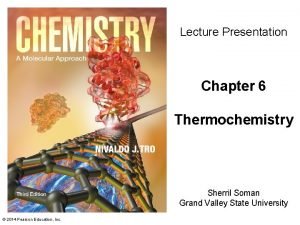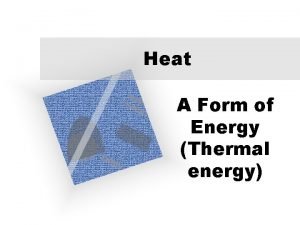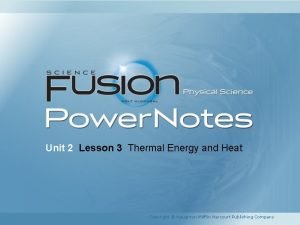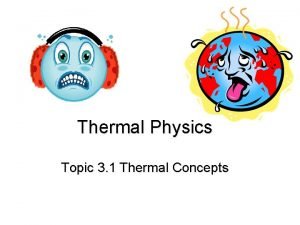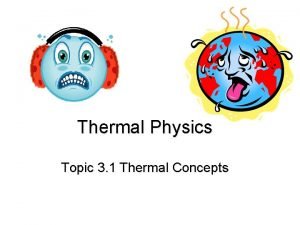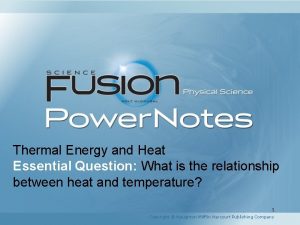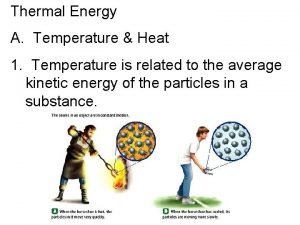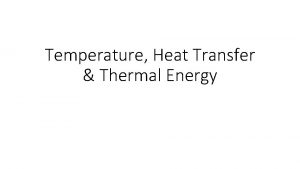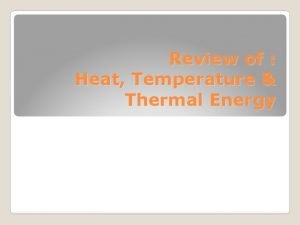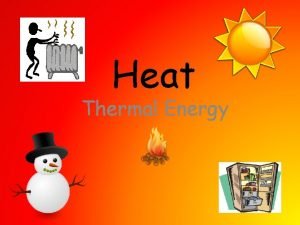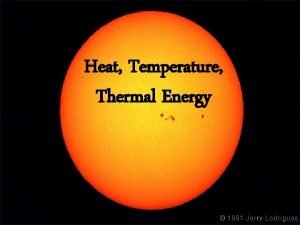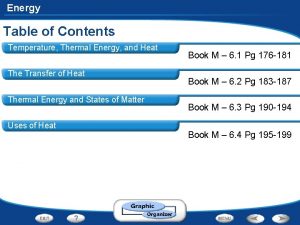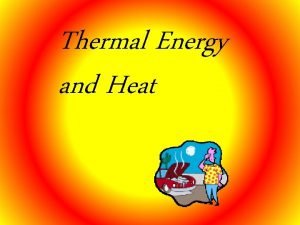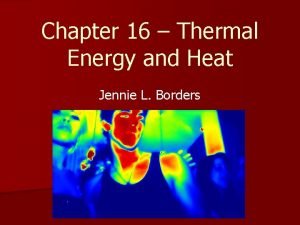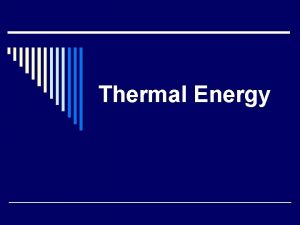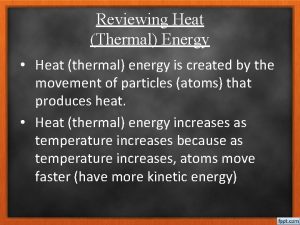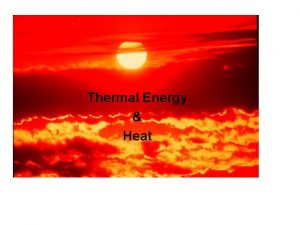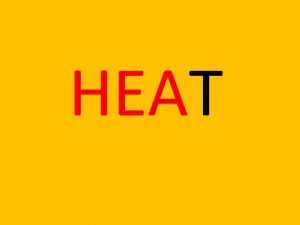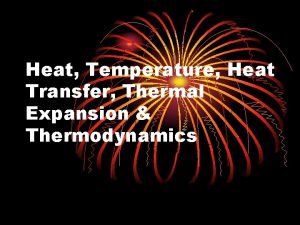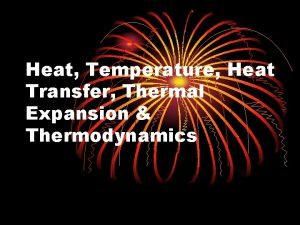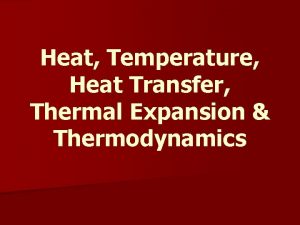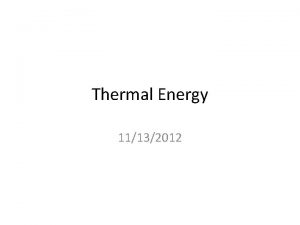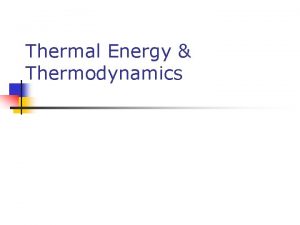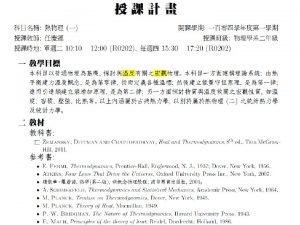THERMODYNAMICS Heat Heat Heat Thermal energy that flows

















- Slides: 17

THERMODYNAMICS Heat

Heat � Heat- Thermal energy that flows from higher temperature objects to lower temperature objects. � In equations: Q � Metric Unit: J � � Heat flows into an object if the temperature of the object is raised. Heat flows out of an object if the temperature of the object is lowered.

Heat � The amount of heat lost or gained is directly proportional to the object’s mass and change in temperature. � Specific heat capacity- A material specific constant pertaining the material’s ability to hold heat. � In equations: c � Metric unit: J/(kg Co) = J/(kg. K)

Specific Heat Example � � A 10 g iron bar at 80 o. C is dropped into 7 x 10 -5 m 3 of water which is initially at 25 o. C. The specific heat of water is 4. 184 x 103 J/kg. Co. The specific heat of iron is 0. 46 x 103 J/kg. Co. What is the final temperature?

Specific Heat Example � � What are we solving for? �Tf What quantities are known? �mi = 10 g = 0. 01 kg �Vw = 7 x 10 -5 m 3 �cw = 4. 184 x 103 J/kg. Co = 4. 184 x 103 J/kg. K �ci = 0. 46 x 103 J/kg. Co = 0. 46 x 103 J/kg. K �Toi = 80 o. C = 353. 15 K �Tow = 25 o. C = 298. 15 K �ρw = 1000 kg/m 3

Specific Heat Example � What are some relevant equations? � Now for some algebra:

Specific Heat Example

Phase Change � � Phase Change – When a substance changes what state of matter it is in. The States of Matter � Solid – When the molecules that make up the substance vibrate in place due to strong bonds. � Liquid – When the molecules that make up the substance have weak bonds and flop around. � Gas – When the molecules that make up the substance have no bonds and attempt to fill their container. � Plasma – When the molecules that make up the substance undergo fission and fusion continuously.

Phase Change � � It takes energy in the form of heat to change the temperature of an object. It also takes energy in the form of heat to change the state of matter from one phase to another.

Phase Change � � � Melting- solid to liquid. Freezing- liquid to solid. Condensationgas to liquid. Evaporationliquid to gas. Sublimationsolid to gas. Depositiongas to solid.

Phase Change � The energy it takes to phase change is directly proportional to the object’s mass and latency. � Latent Heat- A material specific constant pertaining to the material’s ability to release and absorb heat. In equations: L Metric unit: J/kg � �

Phase Change � � There are three types of latent heat. The latent heat of fusion, Lf refers to the change between solid and liquid phases. The latent heat of vaporization, Lv refers to the change between liquid and gas phases. The latent heat of sublimation, Ls refers to the change between solid and gas phases.

Phase Change Example � � � The latent heat of vaporization for apple juice is 2. 26 x 103 k. J/kg and the specific heat of apple juice is 3. 86 x 103 J/kg. Co. Apple Juice boils at about 370 K. How much heat does it take to heat 0. 8 kg of apple juice up from 280 K to 400 K ?

Phase Change Example � What are we solving for? �Q � What quantities are known? �c = 3. 86 x 103 J/kg. Co = 3. 86 x 103 J/kg. K � Lv = 2. 26 x 103 k. J/kg = 2. 26 x 106 J/kg � m = 0. 8 kg � To = 280 K � Tf = 400 K � Tb = 370 K

Phase Change Example � What equations are useful? � How can we combine these equations for this situation? Energy needed to get to the boiling point. Energy needed to phase change from liquid to gas. Energy needed to get to the final temperature.

Phase Change Example

The Laws of Thermodynamics � The 1 st Law � The energy in an isolated system can not be created or destroyed, but transferred. � The 2 nd Law � The � entropy of an isolated system always increases. Entropy – The amount of disorder in a system. � In equations: S � Metric Unit: J/K � The 3 rd Law � No substance can be at or below absolute zero.
 Section 3 using thermal energy
Section 3 using thermal energy Thermal energy flows from
Thermal energy flows from Thermal energy
Thermal energy How are thermal energy and temperature different
How are thermal energy and temperature different Kinetic energy to thermal energy
Kinetic energy to thermal energy Difference between heat and thermal energy
Difference between heat and thermal energy Specific heat capacity of lead j/kg c
Specific heat capacity of lead j/kg c Difference between heat and thermal energy
Difference between heat and thermal energy Thermal energy in states of matter
Thermal energy in states of matter What is the difference between thermal energy and heat?
What is the difference between thermal energy and heat? Energy and temperature
Energy and temperature Thermal vs heat energy
Thermal vs heat energy Heat thermal energy and temperature
Heat thermal energy and temperature Thermal vs heat energy
Thermal vs heat energy Heat flow
Heat flow Thermal energy vs heat
Thermal energy vs heat Q=mct
Q=mct Chapter 16 thermal energy and heat
Chapter 16 thermal energy and heat

